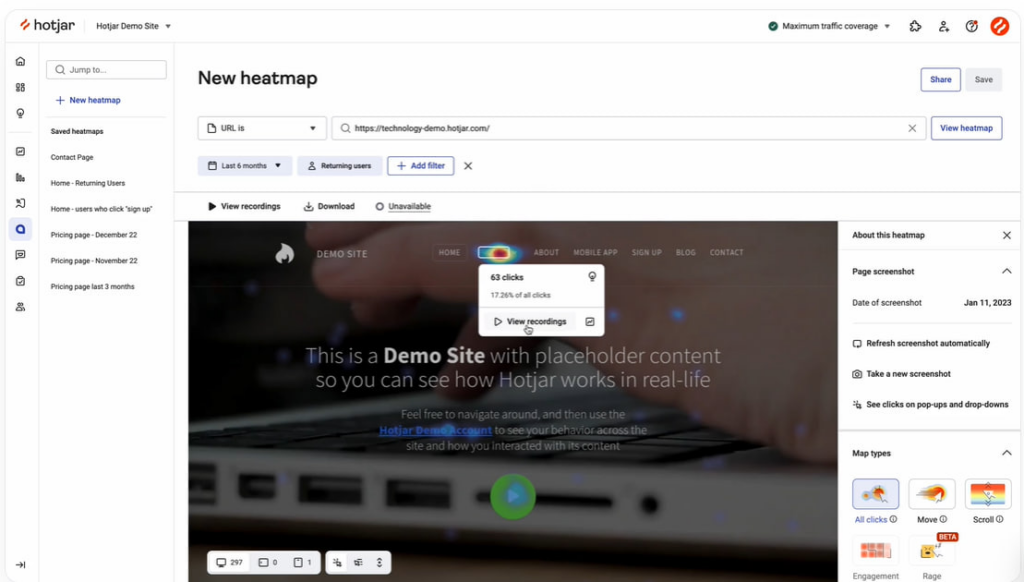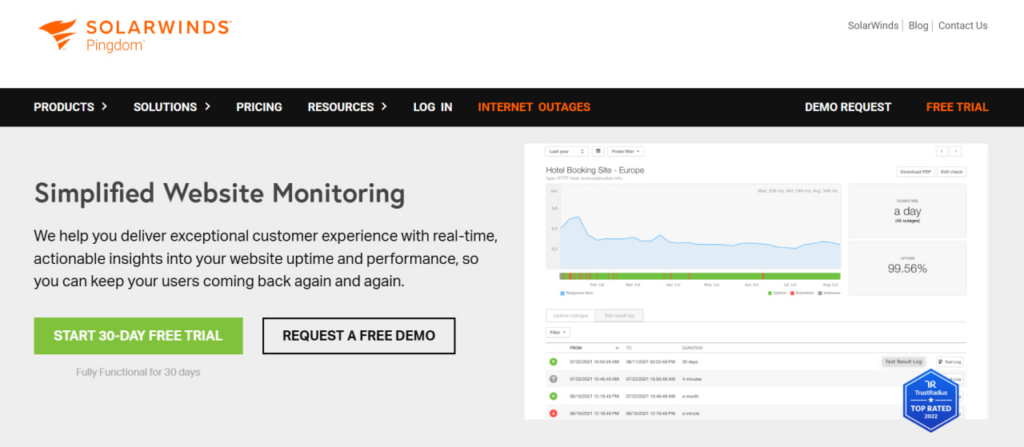E-commerce Monitoring
By Alex Carter on September 16, 2024
People expect a smooth experience during every stage of their online shopping. That’s why e-commerce monitoring activity is so important. You would want to recognize any issues with your site before your clients do.
We want to tell you more about this process. Keep reading and find out how it works and which tools you can use.
All about E-commerce Monitoring
Let’s focus on the general concept of e-commerce monitoring first. It’s a continuous analysis and optimization of different aspects of an online store. The main aim of this process is to guarantee smooth operations and a positive user experience.
Here are the main areas of this type of monitoring. We’re going to talk about key metrics a bit later.
Website Performance
The first essential point is monitoring the speed, uptime, and responsiveness of your website. A slow site or frequent downtimes can result in lost sales and frustrated customers.
So, you need to regularly test
- Page load times;
- Server response rates;
- Performance of critical functionalities.
Moreover, you’ll have to identify peak traffic periods. That way, you can optimize server capacity to prevent unexpected slowdowns or crashes.
Customer Experience
The next area is user behavior. You will understand their preferences and pain points by tracking
- Navigation patterns;
- Time spent on pages;
- Abandoned carts, etc.
For example, you can determine pages with high bounce rates or monitor the CTRs on product recommendations to find areas for improvement.
Also, you can use this info for personalization initiatives. Individual product suggestions and content will also enhance their shopping experience.
Inventory Management
Monitoring of stock levels is important as well. It ensures that popular products are always available and helps you avoid overstocking.
Ongoing inventory tracking allows you to respond quickly to any changes in demand. It minimizes the risk of stockouts or overproduction.
Additionally, integrating inventory data with sales forecasting tools can help you plan for seasonal trends and promotional events.
Transaction Monitoring
You also have to check if payment gateways are functioning correctly. It allows you to confirm the security of transactions and build customer trust.
For a smoother checkout process, monitor for
- Failed transactions;
- Payment processing delays;
- Disparities in order of data, etc.
Plus, you can track refund and chargeback patterns to identify potential fraud or dissatisfaction.
Security Threats
Cyberattackers often target e-commerce sites. So, security is another essential area for monitoring. You have to protect client data, by checking for
- Unauthorized access;
- Data breaches;
- Suspicious activity.
You can track login attempts and use advanced threat detection systems to eliminate these risks.
Why E-commerce Monitoring Matters?
You already know about the purpose of e-commerce monitoring and which areas it includes. Now, you’re probably curious why it matters so much. So, we gathered some reasons why monitoring is important for online businesses.
Higher Customer Satisfaction
Smooth and enjoyable shopping is essential to retaining customers and building loyalty. Monitoring helps you keep your site more responsive. It allows you to handle any problems with loading or confusing navigation. That way, your customers have a positive experience every time they visit the store. This satisfaction often leads to repeat business.
Sales Boost
It helps you identify barriers that prevent people from completing their purchases. You can improve conversion rates and maximize revenue by handling these issues right away. Plus, monitoring tools give details about customer preferences and trends. You can use this info to make your marketing strategies and promotions more effective.
Operational Efficiency Improvements
You have to deal with multiple components when managing a store. From inventory and transactions to website performance. Persistent monitoring helps you simplify these processes by automating the detection of potential problems. There’s less need for manual intervention which can save you time and resources.
Protection of Brand Reputation
Brand reputation online is pretty fragile. Even the slightest security issue or negative customer experience can ruin it. Monitoring can help you avoid it. As we’ve noted above, it helps you identify any attacks or breaches. So, you can maintain a trusting relationship with your buyers.
Main Metrics
You have to understand the right metrics for proper eCommerce monitoring. They are different for each area we highlighted above. So, here are some of the key factors to concentrate on.
Sales
First, we have sales metrics. They measure the general revenue generation and purchasing behavior on your platform. It includes the
- Total sales revenue during a specific period;
- AOV indicates how much people spend on average per transaction;
- Conversion rates show the percentage of website visitors who complete a purchase.
They reflect the effectiveness of your tactics and highlight opportunities for revenue growth.
Customer
These metrics outline how effectively your brand attracts and retains clients. They help you evaluate the value people bring to your business. Here are the main indicators:
- CAC measures the total cost of gaining a new customer;
- CLV estimates the total revenue a client can generate;
- Retention rate indicates how many people return to make repeat purchases.
Website
Next, we have factors that indicate how well your site performs and if it’s usable. The key metrics are
- Traffic volume tracks the number and source of visitors;
- The bounce rate represents the percentage of people who leave the site after viewing only one page;
- Page load times.
Marketing
Also, we have metrics that assess the effectiveness of your promotional campaigns, like
- ROAS measures the revenue you get for every dollar spent on advertising;
- Email open and CTR;
- Social media engagement (shares, likes, and comments).
Inventory
Last, we want to highlight inventory metrics. They help you meet customer demand while minimizing holding costs.
For example, we have stock turnover rates that measure how often you sell and replace inventory during a specific period. High ones indicate strong demand and proper management.
Also, there’s an out-of-stock rate. This percentage shows how often products are unavailable when people want to purchase them.
How to Approach Ecommerce Monitoring
We’ve already defined that e-commerce monitoring is essential for ensuring that your online store operates smoothly and drives conversions. Active monitoring allows you to identify possible problems and optimize your tactics for better results.
How should you approach it? Here are the main steps to follow.
Define Objectives and Metrics
Start by specifying what you want to achieve with your efforts. Focus on the areas we described above for your observation. Clear objectives will help you determine the metrics and tools you need.
Next, decide which indicators matter the most. Find the areas that are lacking, like site performance or inventory.
Pick the Right Tools
Remember that you need strong tools for eCommerce monitoring. We will talk about the best solutions a bit later.
In general, you can use diverse instruments to track performance or downtime. Also, consider various analytics and marketing platforms to evaluate your campaigns.
Plus, you’ll need a database solution. You have to decide whether MySQL vs NoSQL is better for your storage needs.
Set Up Alerts and Dashboards
Proper monitoring depends on timely updates and visualizations. So, configure alerts for critical issues like
- Site downtime;
- Sudden drops in sales;
- Spikes in cart abandonment, etc.
It will help you react quickly.
Also, try to use dashboards to track and visualize key metrics in one place. Group related ones together for a better general picture.
Analyze Regularly
Keep in mind that e-commerce performance data is only valuable if you analyze it regularly. Schedule consistent reviews to identify patterns and lacking areas. Concentrate more on these aspects:
- Seasonal sales fluctuations;
- Customer preferences and purchase behaviors;
- Marketing campaign effectiveness.
Top 5 Tools
We’ve highlighted how important it is to find the right tools for your ecommerce monitoring initiatives. You probably want to know about some practical solutions you can use. So, we gathered some famous tools that might be helpful.
- Google Analytics

The first and probably the most famous instrument is Google Analytics. It has different features that can help you analyze website traffic and user behavior.
The main functionalities it can offer you are
- Sales conversion tracking;
- Traffic source analysis;
- Predictive capabilities;
- Custom analysis and reporting;
- E-commerce tracking;
- Built-in automation.
Hotjar
The next platform you might try is Hotjar. It has different solutions that might be useful for monitoring your e-commerce site.
For example, it has Hetamaps functionality.

It visualizes where users click and scroll. It can help you understand what attracts their attention more and which sections are less engaging.
Also, you can use the Recording feature to see how your visitors view the site. It allows you to determine engagement and frustration scores.
Plus, Hotjar offers different feedback mechanisms to evaluate the opinions of your clients. It presents information in the form of a dashboard where you can see all the critical metrics.
Pingdom

This tool is a great solution for scanning website performance. It offers synthetic monitoring and live user tracking.
The first option allows you to evaluate the functionality of your site with
- Page speed analysis;
- Uptime checks;
- Transaction monitoring.
The second one lets you understand how actual people interact with your site. It gives you a live usage map. Also, it gives you details about various interactions and visualizes activity patterns.
Mixpanel

Another tool we want to suggest is Mixpanel. This data analytics platform gathers information from every client interaction with your business.
It has Cart Analytics and Purchase Funnel evaluation that can help you understand how your visitors make decisions. Also, it provides session replays to analyze areas with high and low impact.
This platform can also help you estimate
- User acquisition;
- Retention;
- Engagement stats;
- Open rates, and more.
Kissmetrics

The last alternative we want to recommend is Kissmetrics. This data analytics solution gives you details about each client of your ecommerce site.
It provides complete reports on customer activity. Also, this platform visualizes information on
- Lifetime customer value;
- Churn;
- Revenue-generating products;
- Acquisition sources, and much more.
Conclusion
We can all agree that ecommerce monitoring is essential for the success of any brand that works online. This activity can help you optimize your site performance and improve customer experience.
You just have to define the main objectives for your monitoring and highlight the metrics that matter the most. Also, keep in mind that this process should be persistent.
Hope that you found something useful! Follow the steps we outlined and try out some of the tools we described.
Posted in blog, E-commerce
Alex Carter
Alex Carter is a cybersecurity enthusiast and tech writer with a passion for online privacy, website performance, and digital security. With years of experience in web monitoring and threat prevention, Alex simplifies complex topics to help businesses and developers safeguard their online presence. When not exploring the latest in cybersecurity, Alex enjoys testing new tech tools and sharing insights on best practices for a secure web.
